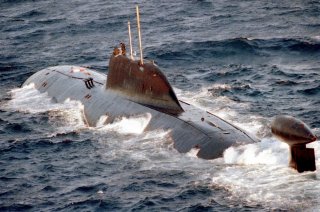Russia and China are Building Super Stealthy Submarines (And This is America's Response)
Thanks to DARPA
With the growing threat posed by advanced adversary submarines such as those being developed and fielded by Russia and China, the Pentagon is exploring novel sonar technologies to counter those new vessels.
One such effort is the U.S. Defense Advanced Research Projects Agency’s (DARPA) Mobile Offboard Clandestine Communications and Approach (MOCCA) program. To that end, DARPA has awarded BAE Systems a $4.6 million contract to develop the new sonar system.
“Modern adversary submarine quieting technology challenges passive anti-submarine warfare sonar detection range and performance,” reads DARPA’s description of the effort.
“The Mobile Offboard Clandestine Communications and Approach (MOCCA) program aims to achieve breakthrough capability for extended range submarine detection and precision target tracking through collaborative operations using unmanned vehicles and active sonar techniques.”
Translated into English, DARPA basically hopes to develop a system that would allow U.S. Navy submarines to detect advanced Russian or Chinese undersea warfare assets such as the forthcoming Project 885M Yasen-class SSGNs, which have very impressive acoustical signatures, without being detected in return. The system would also allow submarines to communicate underwater without betraying their location according to DARPA’s broad area announcement.
“Advances in maritime technology are critical to the Department of Defense and an area where the U.S. military can continue to strengthen its advantage,” Geoff Edelson, BAE Systems director of Maritime Systems and Technology, said in a statement.
“With the resurgence of near-peer competitors and an increasing number of submarines, MOCCA technology will provide Navy submariners with a vital asymmetrical advantage against a rapidly proliferating undersea threat.”
Right now, MOCCA is in Phase 1, which if successful, will lead to Phase 2 and 3 over the course of the next 51 months.
“To meet the MOCCA program’s ambitious Phase 1 goals, BAE Systems’ researchers will design efficient sonar capabilities to maximize detection range and improve target identification and tracking,” a BAE statement reads, but the company was not able to provide much more in terms of additional details about how the system will work due to the high level of security on the program.
While BAE cannot discuss details, DARPA’s broad area announcement offers some glimpses into what the Pentagon hopes to accomplish.
“The MOCCA program seeks active sonar solutions that will mitigate the limits of passive submarine sonar sensors,” the DARPA announcement reads.
“The objective is to achieve significant standoff detection and tracking range through the use of an active sonar projector deployed offboard a submarine and onboard an Unmanned Underwater Vehicle (UUV). The submarine will need the ability to coordinate the operational functions of the supporting UUV. Thus, the program must also demonstrate the ability to achieve reliable clandestine communications between the host submarine and supporting UUV without sacrificing submarine stealth.”
There are two key technical challenges that the MOCCA program must overcome—while also being able to fit into existing U.S. Navy submarines using their existing 21-inch torpedo tubes.
The first challenge is to develop an active sonar system that is small enough to fit onto an Unmanned Underwater Vehicle and bistatic active sonar processing capability that is similarly compact.
“A small UUV is disadvantaged as a host for an active sonar projector. The volume available for the projector is highly constrained which makes high-output transducer materials a necessity,” the announcement reads.
“At the same time, the UUV is energy-limited, so the projector must be as energy-efficient as possible. Relatively long-range ensonification is required, so the ability to focus the projected acoustic signal in a direction of interest is needed to provide additional effective source level at the cost of a requirement to scan the sonar to produce the needed coverage.”
The bi-static component adds another layer of complexity to the problem.
“Bi-static sonar processing advancements are needed in the area of reverberation and clutter rejection as well as precision localization capability,” the announcement reads.
“The system will be operated in bottom-limited acoustic environments. Sound that is projected will be scattered, producing reverberation and signal loss. Scattered sound may inadvertently illuminate the host submarine and possibly compromise stealth.”
The second key challenge will be to control the UUV from extended ranges from onboard a nuclear-powered attack submarine without compromising the vessel’s position.
“The communications link between the host submarine and the UUV will be used to control the UUV and its sonar payload, and to communicate information generated on the UUV back to the host platform,” the DARPA announcement states.
“The MOCCA system will be used during an engagement, so proper control of the UUV is critical. Link throughput, delay, and reliability trades should consider the need for reliable operation during combat. An ideal link would have a low probability of intercept and of exploitation and provide high link reliability. The MOCCA communications link cannot degrade submarine stealth.”
The MOCCA will be a challenging program—otherwise it wouldn’t be a DARPA-led effort.
“The MOCCA sonar and communications data transmission, collection and processing cannot impact existing submarine operations – the MOCCA submarine processor and display will be adjunct equipment approved for on-board submarine operation and interface with submarine systems,” the announcement reads.
“Digital sonar signal data will be available for MOCCA sonar processing at the output of submarine sensor signal conditioning and analog-to-digital conversion processing.”
If the MOCCA program succeeds, it might help to ensure that the U.S. Navy continues to lead other would be great power challengers and their increasingly potent undersea forces. It would also help to resolve long-running issues with secure, stealthy underwater communications. However, success is not guaranteed—DARPA only takes on the toughest challenges.
Dave Majumdar is the defense editor for The National Interest. You can follow him on Twitter: @Davemajumdar.

